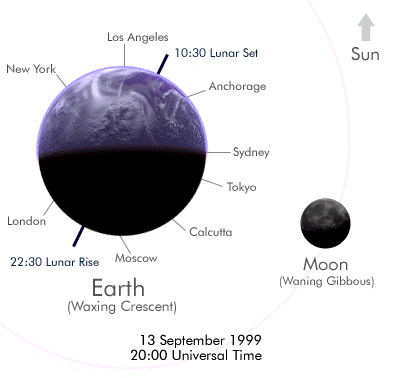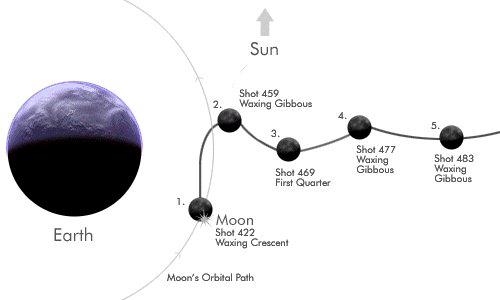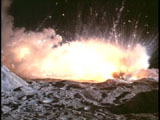Features: Articles & Interviews
"Breakaway": Observations on time units and lunar position
In the Space: 1999 universe, Monday, 13 September 1999 is known as "Breakaway." (This is also the name of the premiere episode.) It is during this tragic event that a massive chain of nuclear explosions hurl the Earth's moon from it's orbit and into interstellar space, likely with the unseen help of a Mysterious Unknown Force (M.U.F.).
This article examines the time units during the Breakaway event, as well as the Moon's position in (and out) of Earth orbit. We remind everyone that while Space: 1999's reality may break some rules of physics, in the Space: 1999 reality these discrepancies are fact. (This television series is part of the science fiction genre!) To quote the famous philosopher, Bugs Bunny, "I haven't broken any laws of physics. I haven't studied law."
Time Units
Two assumptions were made with this analysis.
- That the International Lunar Commission uses the Universal Time for all extraterrestrial programs.
- The digital clock shown on the communications post was set to Universal Time.
Let's begin...
During Act 3
- Commissioner Gerald Simmonds meets with Commander John Koening, Dr. Helena Russell and Professor Victor Bergman on Moonbase Alpha over Koenig's Emergency Code Alpha One.
- Six Eagles are converted and flown into Nuclear Disposal Area 2. They begin to disperse nuclear waste upon the lunar surface.
Note: On the communications post in the Main Mission command office, the analog clock shows 6:42; the digital clocks shows 4:42. Act 3 Shot 387. Clock error?
To continue:
- Eagle 26 disperses waste to Grid C nine.
- Grid D is full. Moving to Grid E.
- Navigation failures with two Eagles. They have been replaced.
- Altitude increased by 10.
- All Eagles are committed to the dispersion of nuclear waste containers.
- Captain Alan Carter ordered by Koenig to take the Commissioner's Eagle into lunar orbit.
- Heat levels holding. Magnetic fields fluctuating.
- Altitude increased another hundred.
- Carter lifts off. E.T.A. for lunar orbit: 4 minutes.
During Act 4
Note: Earth is shown as a waxing Crescent over Moonbase Alpha. Act 4 Shot 422.
- Levels are holding steady.
- Commissioner Simmonds gives congratulations.
- Nuclear Disposal Area 2 erupts.
- Mission aborted by Koenig. All Eagles to return to base.
- All sections of Moonbase Alpha sealed off.
- Moon is violently shaken.
Note: Earth is shown as a waxing Gibbous over Moonbase Alpha. Act 4 Shot 459.
- Moon is moving. G Forces pin down personnel.
- Space dock is destroyed. Meta Probe spun away.
Note: Earth is shown in the first Quarter from lunar orbit. Act 4 Shot 469.
- Carter's Eagle is able to stay in close orbit with the Moon, despite the Moon's acceleration.
- Carter calls Moonbase Alpha.
Note: Earth is shown as a waxing Gibbous from lunar orbit. Act 4 Shot 477.
- G forces lessening.
Note: Earth is shown as a waxing Gibbous from space. Act 4 Shot 483.
- Commander Koenig contacts Carter.
- Moon at 3g acceleration. Moonbase Alpha gravity generators are compensating.
- Carter says he can make it back to Moonbase Alpha.
- All sections report to Main Mission.
Note: On the communications post in the medical center the digital clocks shows 20:18. Act 4 Shot 505. The analog clock was only partially shown.
- Paul Morrow gets video from the Mars satellite.
Note: Earth and the Moon was shown in the first Quarter from Mars orbit. Act 4 Shots 507 and 510.
- "Human Decision Required" by computer for Operation Exodus.
- Carter is back at Main Mission.
- Commander Koening announces command decision to stay on Moonbase Alpha.
Note: On the communications post in the medical center, the analog clock shows 8:23; the digital clocks shows 20:23. Act 4 Shot 533. Clocks are the same.
From the time line we can gather the following facts:
- The date of the incident was Monday, 13 September 1999.
- That day at 4:42 Universal Time, the dispersion of nuclear waste Nuclear Disposal Area 2 began.
- Minutes after the explosion of Nuclear Disposal Area 2, MBA sections were reporting to Main Mission at 20:18 Universal Time.
Conclusions:
- The dispersion of nuclear waste took about 16-½ hours before the project was aborted.
- The Earth shows as a Waxing Crescent over Moonbase Alpha before the explosion. Thus the Earth's view of the Moon would be a Waning Gibbous.
- It takes Carter 4 minutes to get into lunar orbit. Then it would take 4 or more minutes to get back to base. It would take a few minutes for the medical section to report to Main Mission. And it would also take time for everyone to be able to perform duties after the heavy lunar acceleration. With this in mind, I would place the explosion from 19:45 to 20:05 Universal Time.
Lunar position
One question asked by Space: 1999 fans: Which side of the Earth would witness the "Breakaway" events? Based on the time units, the Moon is a Waning Gibbous at 20:00 Universal Time when Nuclear Disposal Area 2 ignited.
In the month of September of the Northern Hemisphere, the Moon will rise at approximately 22:30 Universal Time (22.5°E longitude) and set approximately 10:30 Universal Time (157.50°E longitude).
(Universal time is located at 0° Longitude.)
Table 1
| City | Longitude | Local Time | Date (year 1999 A.D.) | Lunar Observation |
| London | 0° | 8:00 p.m. | Sept. 13 | A slight glow to the east. |
| Moscow | 37° 35'E | 11:00 p.m. | Sept. 13 | Moon is just rising. |
| Calcutta | 88° 22'E | 1:30 a.m. | Sept. 14 | Moon half way to it's zenith. |
| Tokyo | 139° 46'E | 5:00 a.m. | Sept. 14 | Moon just passed it's zenith. |
| Sydney | 151° 13'E | 7:00 a.m. | Sept. 14 | Half way down from zenith. |
| Anchorage | 149° 54'W | 11:00 a.m. | Sept. 13 | A slight glow to the west. |
| Los Angeles | 118° 14'W | 12:00 noon | Sept. 13 | None |
| New York | 74° 0' W | 3:00 p.m. | Sept. 13 | None |

Projected Lunar Trajectory
VICTOR BERGMAN: "We're down to three G's! We're compensating. You see, the whole Disposal Area has been acting like a gigantic rocket motor, pushing us out of orbit."
COMPUTER: "Indefinite Factors.
- Moon on Unknown Trajectory
- Constantly Changing G Forces Due To Moon's Movement Away From Earth
- Insufficient Data To Compute Flight Plan"
The Disposal Area was acting not truly like a rocket motor, but more like an inflated balloon being released. The "rocket exhaust" was not controlled as on a spacecraft with its thruster bells. It is the author's belief that when Nuclear Disposal Area 2 erupted, it first spun the moon (everyone was violently shaken). Then as the nuclear disposal area started to reach a high degree of thrust, the far side of the Moon was first facing Earth, then spun towards the Sun. The Moon was now moving in the proper positions to break out of Earth's orbit (due to high G forces, putting aside any logical physics models).
Even when all sections of Moonbase Alpha were reporting in, the Moon was still rocketing away. Under 3 g's, Moonbase Alpha's artificial gravity system was presumed to compensate and provide the normal 1g gravity environment.
By analyzing the view of Earth, we can gather what trajectory the Moon would have taken as it was blasted out of orbit.
Table 2
| View of Earth | Taken from | Act/Shot | Trajectory |
| Waxing Crescent | Over Moonbase Alpha | 4 / 422 | Explosion starts, Moon spins |
| Waxing Gibbous | Over Moonbase Alpha | 4 / 459 | Moon moves towards the sun |
| First Quarter | Lunar orbit | 4 / 469 | Moon U-turns back |
| Waxing Gibbous | Lunar orbit | 4 / 477 | Moon breaks out of orbit |
| Waxing Gibbous | Outer space | 4 / 483 | Fissioning slowing. Down to <3 G's |
| First Quarter | Mars orbit | 4 / 507&510 | Moon heads between Earth and Mars |
(Writer's supplement: I believe that at first the Moon traveled in the same plane of the solar system, because the moon was heading towards the Mars satellite. What happens afterward is anyone's guess.)

Our Reality vs. Space: 1999 Reality
On 13 September 1999, the Moon was a Waxing Crescent with an illuminated fraction of 0.184. It will be 3.5 days before the first quarter. Our Moon is almost 180° opposite from the Space: 1999 reality.
From Mars orbit, the satellite should have shown the Earth and moon in the Last Quarter. The Space: 1999 reality shows it in the First Quarter. So, Mars in our reality would be lagging 90° in its orbit from what the Space: 1999 reality has it.
Copyright 1999-2003 www.Space1999.org. All Rights Reserved. Legal
notice.
This work is licensed under a Creative
Commons License, in conjunction with our Open Source Content
Model. This site uses XHTML and CSS and looks best with a standards compliant browser.






